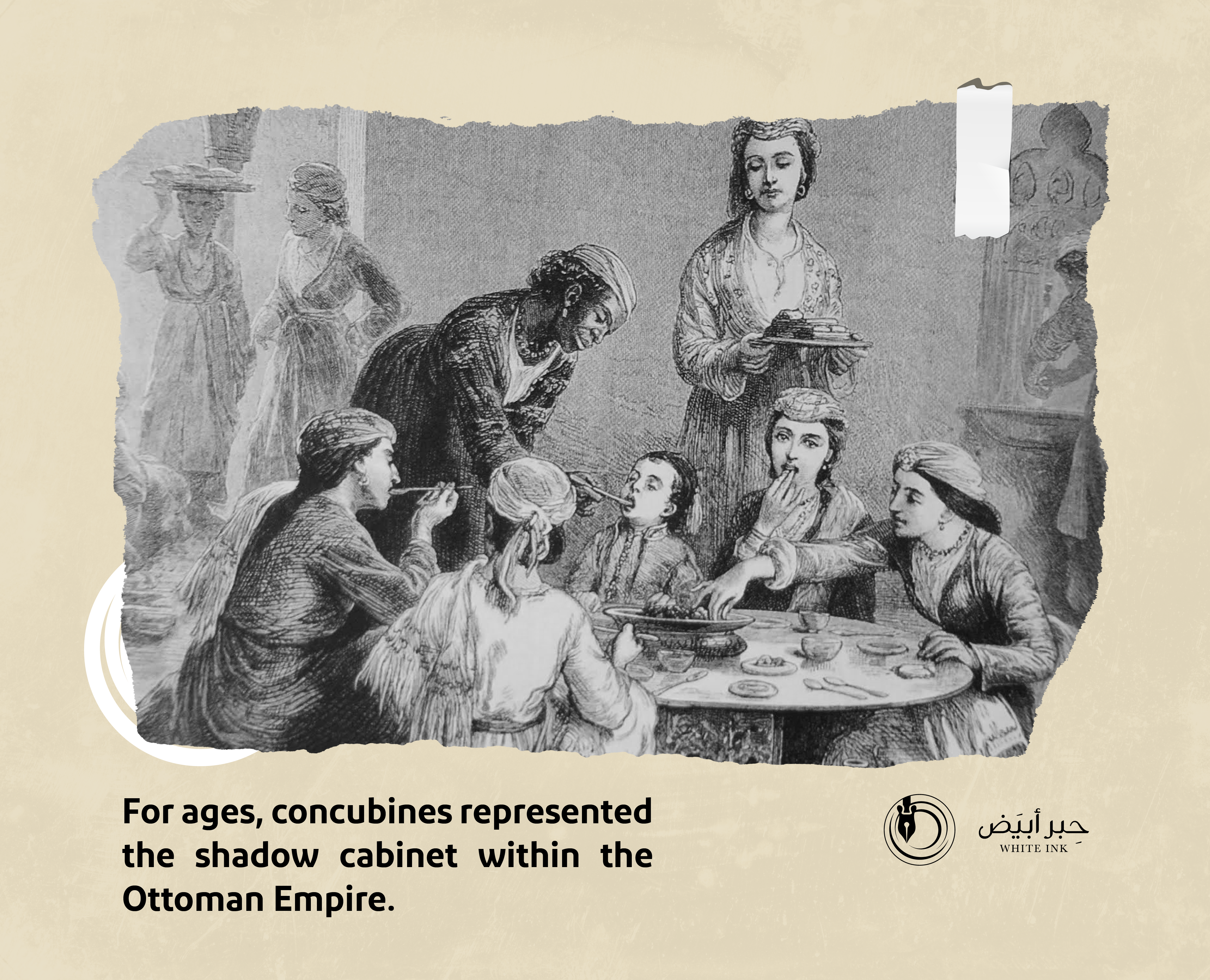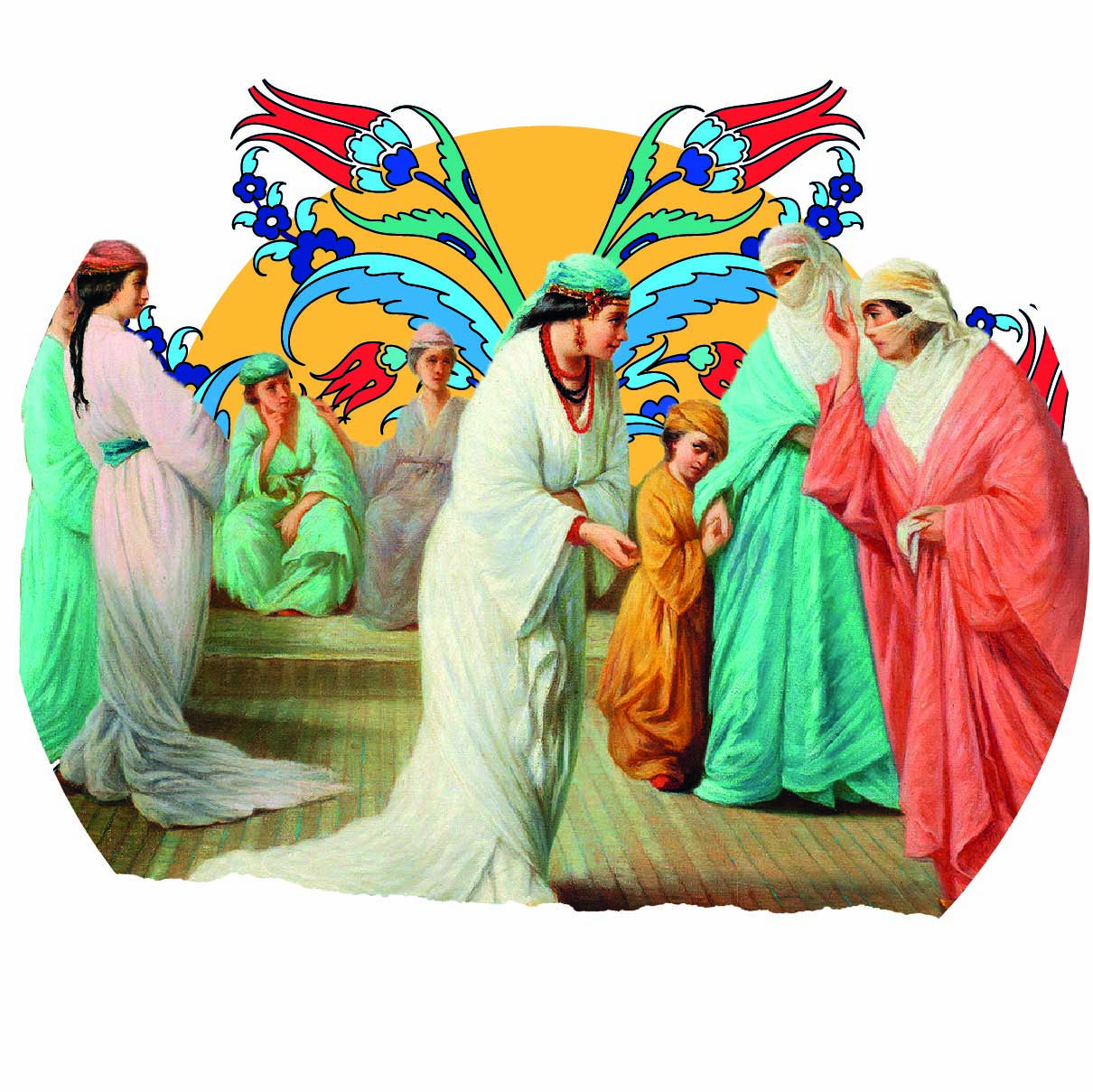
The seat of actual ruling of the sultans of the Ottoman Empire
The “Haremlik"
Where wives, maidservants
and the rest of women were profaned!
The presence of women and maidservants in the palaces of the Ottoman Empire was not a new thing. The empires throughout history witnessed this phenomenon; however, the Turkish sultans were not satisfied with a few women as before, but superseded to buy girls from all over the world, and established Haremlik Institution, which included the maidservants and wives of the Ottoman sultans, and they set strict laws for that Institution and created posts for maidservants, where they worked their way up to it until they became mothers of the sultans and rulers in the countries ruled by the Ottoman family.
This evolution, which historians described as an indication of how the Ottoman sultans panted after women and, fun gatherings and relaxing on beds, leaving the governance affairs, is what eventually led to the Haremlik, which is the place reserved for women in the palaces of the Ottoman sultans, the real seat of the country’s rule and from which decisions were issued and plots that threatened the pillars of the Ottoman Empire before leading to its fall were hatched.
Historical sources also confirm that Ottoman sultans did not have private suites for the Haremlik in their palaces until the reign of Sultan Mehmet Al-Fateh (1444-1481), who was fond of women, so he gathered hundreds of maidservants and wives and allocated a place for them inside the palace and called it the “Haremlik” – where it was forbidden for men to enter.
Mehmet Al-Fateh established the Haremlik to keep his wives and maidservants under surveillance

On the other hand, Sultan Mehmet Al-Fateh wanted to keep an eye on his women and his maidservants, as some of the maidservants belonged to empires hostile to the Ottoman Empire, and the women of the Haremlik were brought from the slave markets that were promoted by the Turkish sultans, and there were merchants whose task was to search for a beautiful girl worthy of the Haremlik of the Ottoman house who they spent thousands of gold liras for their own pleasures and lusts.
Therefore, the Ottoman sultans created the order of Aghas, i.e., eunuchs who were apparently assigned to serve the Haremlik, but their actual task was to keep an eye on these women and track their movements.
Ever since the Haremlik was established, secrecy and strict laws were imposed, and it is no exaggeration to say that this place was on the top priorities of the Ottoman sultans who cared for women first and foremost.
Sultans opposed full secrecy on the women of Haremlik and they killed any man who approached them

This is demonstrated by the fact that the Haremlik was directly observed by the Ottoman Sultan. As for the architectural divisions of the Haremlik; historical sources show, it consisted of several overlapping buildings of suites and rooms, and corridors leading to entrances and exits to restrict internal movement, and it also included secret passages for the sultans to enter and exit.
The Haremlik contains more than 400 rooms for the family of the sultan and his maidservants, as well as suites for servants and female workers to take care of the maidservants and accompany the sultans’ wives. The Haremlik also contains bathrooms, salons, and libraries. Undoubtedly, this place was kept out of sight inside the palaces and remained a mysterious part even for workers in the palace itself.
As for the rules of the Haremlik, it can only be described as extreme slavery rules, starting with forcing all maidservants and female slaves to convert to Islam involuntarily, which is something forbidden by Islam in clear and explicit texts, then upbringing them on some of the enslavement rules imposed by the Ottoman sultans, they are forbidden to look to the Sultan in his eyes, and the tip of his dress must be kissed when he approaches any maidservant, and they are not allowed to leave the Haremlik, and of course they must prepare themselves every night in anticipation of the desire of the Ottoman sultans.
To make sure that no one knows what the sultans of the Turks do inside this mysterious part of the palaces, brutal punishments were imposed on the women of the Haremlik. Whoever violates the instructions of the Sultan is to be kicked out to the doors. As for the maidservant who has an affair with any man, her fate is death.
For men, any man approaches the Haremlik, his death is inevitable. Historical sources indicate that a merchant from the citizens of the city of Venice dared and tried to look from a distance at the suites of the sultan’s Haremlik using binoculars. Soon enough, he was discovered; Sultan Murad IV (1623-1640) would have hanged him immediately, and the attempt was repeated by an Armenian man working as a translator for the French ambassador in Istanbul, the Ottoman authorities arrested him and quickly hanged him before the French authorities intervene to ask for a pardon.
Although Allah did not distinguish between people except by work, the Ottoman family has always divided people into classes and categories. Within the Haremlik itself, women were not equal. There are posts and ranks, and the influence of a maidservant is determined by her beauty and the Sultan’s admiration for her.
The hierarchical system within the Haremlik was headed by the “mother of Sultan”, who is the most important figure within the Haremlik as the mother of the ruling sultan, and she was the only one allowed to communicate with the outside world. As for claiming this post, it is obtained once a new sultan from the Ottoman family is appointed, his mother assumes this post.
Historical sources reveal that the mother of the Sultan played other important roles by providing the necessary consultations to the Sultan regarding the Haremlik and the behavior of the women within. In other words, she is the first spy of the Sultan among his women.
The Sultan’s mother presided Haremlik and she was significantly influential due to her position.

After Sultan’s mother, the role of the ” Kadınefendi” comes to the surface, this term means the class of maidservants who gave birth to a son to the ruling sultan. Once they deliver the child, they move to that class, which enjoys special treatment, as maidservants are assigned to serve them as mothers to the sultans’ children.
The one who gives birth to the eldest son of the Sultan is called “Bashqadin”, as she becomes practically the next mother-sultan within the Ottoman Haremlik, according to the laws of the Ottoman state.
In third place comes the “Al-Jouza”, Such word implied, the maidservant who was able to capture the attention of officials inside the palace, whether the sultan himself or others, and such obsession allowed her to rise within the Haremlik. As for the one who temporarily captured the Sultan’s attention, she was called “Iqbal”, and she also had a special position within the Haremlik.
Then comes at last “Al-Kalfa”, which refers to the group of maidservants who have important jobs to run the affairs of the Haremlik, and they enjoy a higher prestige than the rest of the servants, the list of such group of maidservants includes maidservants who have routine tasks such as jewelry keeper or treasurer inside the Haremlik.
In spite of this strict system set by the Ottoman sultans, and the complete secrecy that imposed by the Ottoman sultan on entertaining gatherings and the Arabian Nights and days lifestyle “one thousand and one nights”, which they had with the money of Muslims who suffered in their reign of poverty and underdevelopment, this regime did not last for long. Soon enough, everything that was occurring within this mysterious part of the palaces was revealed.
Historical narratives confirm that living inside the Haremlik violated all the prohibitions forbidden by Islam, and the Haremlik only satisfies the desires and the cravings of the Ottoman sultans who built basins of milk in which the maidservants bathe. Walls of the Haremlik also witnessed what can be described as vulgar poems to sexually arouse the maidservants and beautiful women, not to mention other actions that historians were ashamed of mentioning.
Moreover, many of the agha’s who served the maidservants and women of the Turkish sultans were able to make a fortune, whether in exchange for their service to the women of the Haremlik or by managing the money of some women, especially the wives of sultans. The wealth of some Aghas exceeded the wealth of the pashas and ministers of the Ottoman Empire.
Haremlik witnessed the most heinous forms of immorality and depravity by the Ottoman Sultans.



- Ahmad Al-Shintnawi and others, Encyclopaedia of Islam (Beirut: Dar Al-Marefah, d.t.).
- Amani Al-Ghazi, The Ottoman Empire through the writings of orientalists in the Islamic Encyclopedia (Jeddah: Cultural Works, 1433 AH).
- Ekmeleddin Ihsanoglu, The Ottoman Empire, History and Civilization (Istanbul: Research Center for Islamic History, Arts and Culture, 1999 AD).
- Hassan Al-Dika, The Ottoman Empire, Culture, Society and Power, (Beirut: Dar Al-Natkheb Al-Arabi, 1997).
- Khalil Enalcik, History of the Ottoman Empire from Origin to Decline, translated by Muhammad Al-Arnaout (Al-Mdar Al-Islami, Benghazi, 2002).
- Abdulaziz Muhammad Al-Shinawy, The Ottoman Empire: A Forged Islamic State (Cairo: The Anglo-Egyptian Bookshop, 1980 AD).
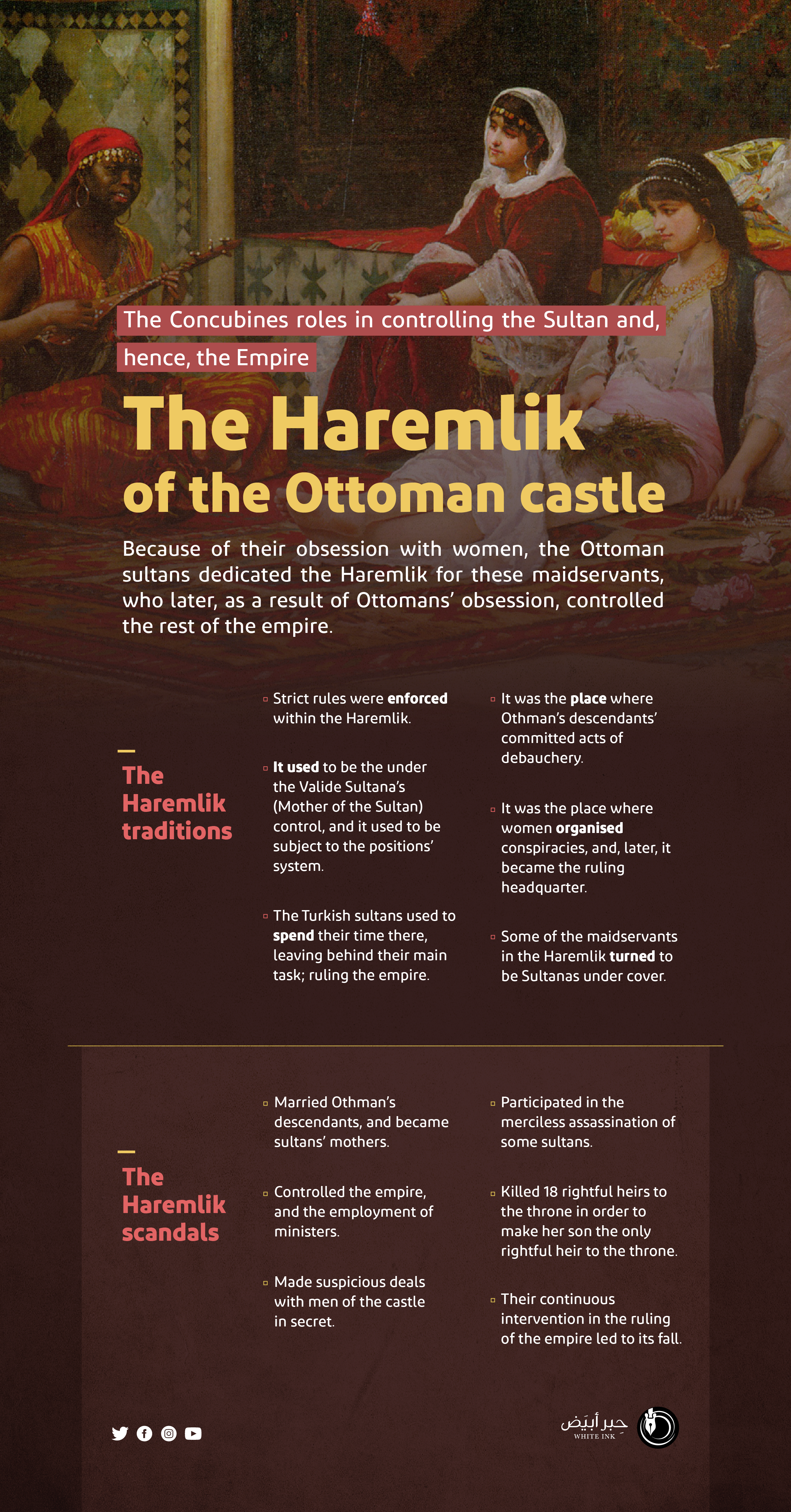
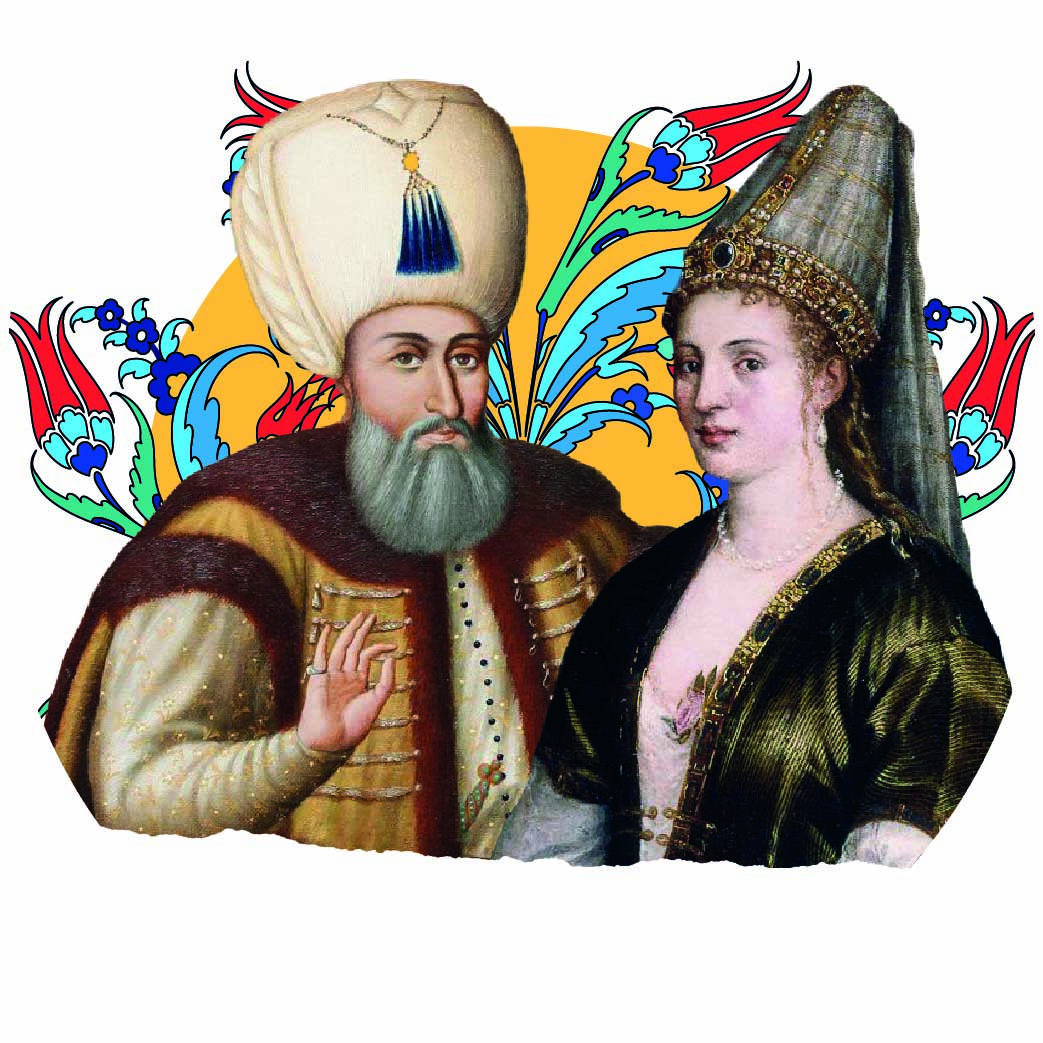
From slave Markets to the head of the Ottoman Empire
Sultanas in the Haremlik who ruled in the shadow
History tells us that every country had men working in the shadow, who do not have official posts in the state and do not appear much in public, but in secret they manage and control the fate of the country and the people.
This phenomenon may have been resorted to by the leaders of the countries to find a last resort when the officials fails to come out with solution, thus it was justified, but what the Ottoman sultans did, was groundless, because they did not have men working in the shadow but instead; they have women working in the shadow, and these women were only maidservants, who were brought from slave markets from far and wide, and because of the desires of Ottoman family and falling in the arms of the maidservants day and night, the fate of the country became in the hands of the women of the Haremlik, so they controlled the Turkish sultans; arguably, we can say that they became the sultanas ruling in the shadow.
Historical sources indicate that ever since the Haremlik was established during the reign of Sultan Mehmet Al-Fateh (1444-1481), arguably, we can say that such place assigned to the maidservants and women of Ottoman family was the seat of the actual ruling in the country. On the one hand, the Ottoman sultans spent most of their time among their maidservants, and on the other hand, that state of weakness that dominated the Ottoman family tempted these women to release their desires to gain influence and wealth until they became in control of the country.
As for the maidservants, the path was paved for them. It is enough for a maidservant to effectively tempt the Sultan to fall in love with her, and when she delivers a child to him, she is promoted directly to “Kadin”, which is a rank in the laws of the Haremlik that makes her treated as one of the sultanas, and when the son of that maidservant takes the throne, such maidservant becomes the mother sultana afterwards, the most prestige position in the Haremlik, and she is more influential than some of the sultans.
As a result of the multiplicity of maidservants and the infatuation of the Turkish sultans with them, there were always maidservants who had children from the sultans, which ignited the conflict that which of them would her son seize the throne, and because of that many of these women also hatched plots and assassinations in order to secure the position of Sultan for her son.
Some may think that the dominance of the Sultana of the Haremlik appeared in the era of the decline of the Ottoman Empire or the end of its decades, actually, such phenomenon began early to become a political doctrine for the Ottoman family. Historical sources prove that everything started from Sultan Suleiman the Magnificent (1520-1566) AD, who was fond of “Roxlana”, a maidservant of Ukrainian origin and a Christian father, who was captured and became one of the other maidservants in the Haremlik.
In no time, Roxlana became an obsession to Suleiman the Magnificent, and he was mesmerized with her and wrote poems about her. Then that concubine delivered him a son, and she turned into his wife and his first advisor of state affairs. Historians describe Roxlana’s influence making Suleiman the Magnificent unable to abandon her site, to the extent that prompted him to give up the leadership of his military campaigns.
Roxlana, the concubine of Suleiman the Magnificent, the first Sultana of the Ottoman Empire ruling in the shadow

Roxlana did not care about this weakness of the lover sultan, her cunning plans and her strong personality was what prompted her to think about how to bring her son Selim II to power, in this sense, she created a strife between Suleiman the Magnificent and the Grand Vizier Ibrahim Pasha, who was in favor of taking the throne to Prince Mustafa.
Roxlana’s plan worked, so Suleiman the Magnificent dismissed Ibrahim Pasha and appointed Rustam Pasha in his place, who married one of Roxlana’s daughters, then moved to the third step by deluding the Sultan that his son was conspiring against him, and in 1553 AD Mustafa Suleiman the Magnificent was murdered, and after the death of the latter, Sultan Selim II son of Roxlana was crowned sultan.
What Roxelana did, turned into a rule in the Ottoman Empire as rules for killing siblings and starving people. When Sultan Selim II took power (1566-1574) AD, there was a maidservant called ” Nurbanu ” who controlled him until she married him and gave birth to Murad III, who will subsequently rule.
Nurbanu was able to control all the affairs of the Ottoman Empire during the reign of her husband Selim II & her son Murad III, due to her resourcefulness, she allied with the Grand Vizier Sokollu Mehmet Pasha, and the chief of the Aghas in the palace, Ghazanfar Agha, an alliance to which Sultan Selim II and his son Murad III acquiesced.
Such things took a dramatic turn when a maidservant called Safiye appeared, who was bought by Sultana Huma Shah, daughter of Prince Muhammad bin Suleiman the Magnificent, and gifted her to Murad III when he was the crown prince.
Such maidservants controlled the Ottoman sultans and ruled the Ottoman Empire

Safiye was able to take away the mind of Murad III, who became distracted between his powerful mother on one hand, and his favorite maidservant Safiye on the other. To solve this dilemma, Nurbanu tried to change the fact that Safiye is the favored concubine in the bed of Sultan Murad III; but the latter refused at first before submitting to the will of his mother and accepting other maidservants.
Safiye did not give up easily, so she insisted on staying next to Murad III and was able to give birth to Prince Mehmet Khan, who would later become Sultan Mehmet III (1595-1603) AD. The conflict ended when Murad III’s mother died by poisoning in 1583, and Safiye Sultan became the most influential person within the palace.
In order to know the extent of the crimes committed by Safiye Sultan, A.K.A. the butcher of the Ottoman family. Historical sources elucidate that in order to eliminate any competitor to her son, she ordered that the male princes of the Ottoman family be imprisoned in suites isolated from the world inside the Haremlik, which left grave effects on those who survived afterwards, as they all suffered from mental illnesses as a result of what Safiye Sultan did to them.
Safiye Sultan carried on with her crime while the Ottoman Sultan Murad III was breathing his last, so she ordered the chief of the Aghas, Ghazanfar Agha, to kill the Sultan’s 18 male sons by suffocation to clear the way to her son.
In order to confer the throne to her son, Safiye Sultan killed 18 of Murad III's sons

Same happened with ” Kosem Sultan”, who was sold as a maidservant and turned into one of ladies in the Ottoman family, after she was able to marry Sultan Ahmed I and gave birth to Prince Murad, Sultan Murad IV later.
Kosem Sultan was able to make alliances with statesmen in the palace to secure the position for her son against his brother, Prince Othman the son of a fellow wife and her historical enemy, “Khadija Mahfiruz.”
Kosem Sultan settled the matter in favor of her son. After Prince Othman ruled and became Othman II, she conspired to assassinate him, later on her son Murad, at the age of 11, she took power and ruled the country as the Sultan’s deputy for 9 years until Murad IV reached the age of twenty. Her influence did not end there, but continued throughout the reign of her son.
Historical sources unanimously agree that leaving the Ottoman Empire in the hands of sultanas, who ruled in the shadow, and what they did was one of the main reasons for the fall of the Ottoman Empire and the backwardness that Muslims suffered from, and historical narrations also confirm that there was no sultanate known in history in which women ruled in explicit and dangerous manner as well.
Kosem Sultan managed to assassinate Othman II and rule the country instead.



- Ismail Yaghi, The Ottoman Empire in Modern Islamic History (Riyadh: Obeikan Library).
- The Unknown Ottoman Empire – Ahmet Ak Kunduz, Said Ozturk.
- Publication – Saltanat Al-Dam .. “Safiye” the butcher of the princes of the Ottoman family. Researcher Mahmoud Al-Batakushi.
- Sayyid Muhammad Al-Sayyid Mahmoud, The Ottoman Empire, Origin and Prosperity According to Contemporary Ottoman Sources and Modern Turkish Studies (Cairo: Al-Adab Library, 2007).
- Abdel Rahim Benhadda, The Ottomans, Institutions, Economy and Culture (Casablanca: Sebou Telecom, 2008).
- Magda Salah Makhlouf, The Haremlik in the Ottoman Era (Cairo: Dar-Alafak, 1998).
- Muhammad Jamil Bayyuhum, The priorities of the city sultans of Turkey social and political (Sidon: Al Wefaq Press, 1930 AD).
- Muhammad Suhail Taqqoosh, History of the Ottomans – the Establishment of the State to the Coup against the Caliphate, 2nd Edition (Beirut: Dar An-nafaes 2008).
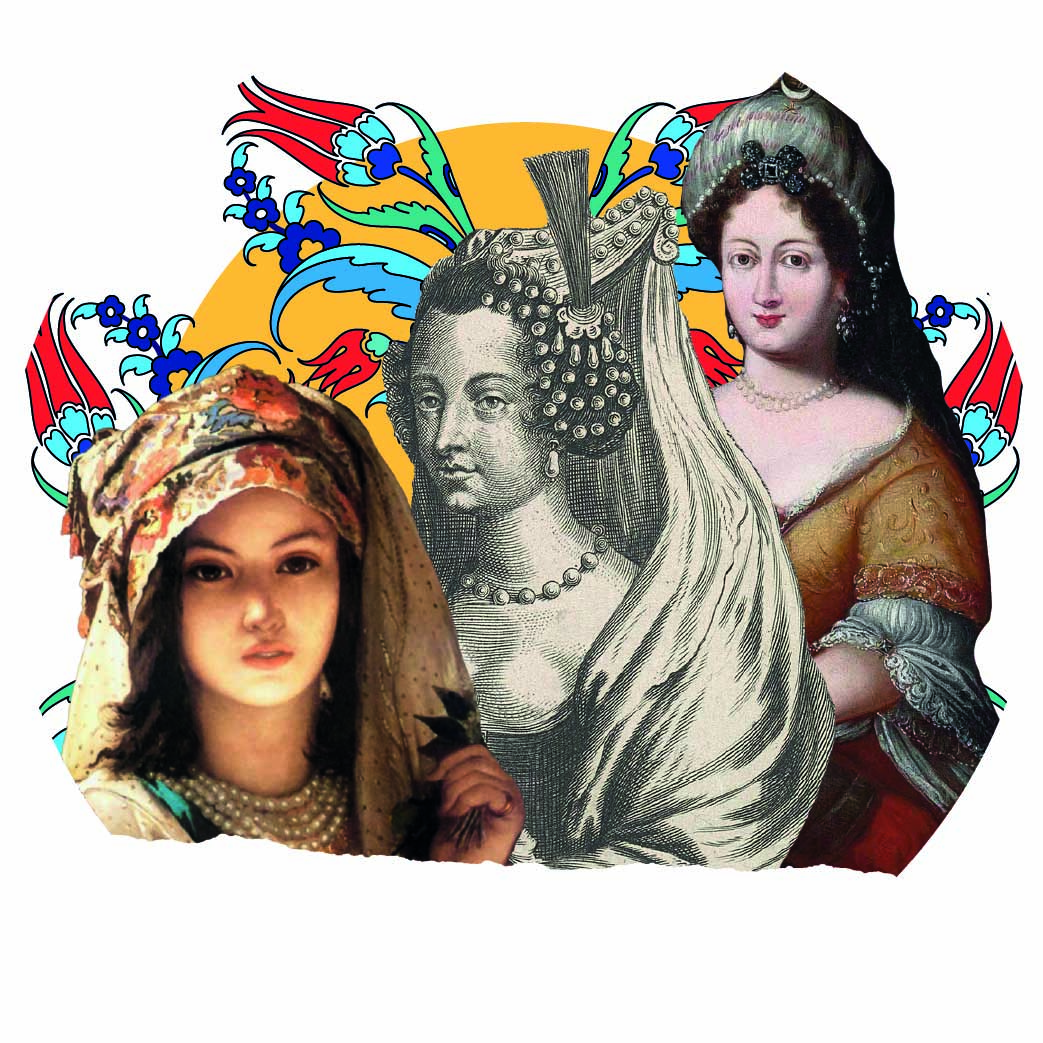
Corruption spread by the Haremlik and the conflict between the sultans was ignited
How did the Ottoman Empire
collapse by the maidservants?
Of course, this influence, as the historical sources show, would not have been in this way; had it not been for the weakness of the Turkish sultans who neglected the affairs of government in order to satisfy their vile desires. At a time when Muslims were suffering from poverty and hunger, the Ottoman sultans used to spend thousands of golden liras on private parties that they held in their palaces.
We can add to this that some of the Ottoman sultans fell in love with many concubines and became subject to their orders. Many of these concubines belonged to enemy countries of the Ottoman Empire.
They deprived the Arabs of food and spent their gold liras on their vile desires.

The extent of the influence of the Haremlik appeared early through Khandan Sultan (Turkish: Handan Sultan), the mother of Sultan Mustafa I (1617-1623) AD. It was the woman who presided over the Haremlik. She caused a strife among the Janissaries’ aghas and incited them to kill Sultan Othman II, as part of the fighting over the throne. What she wanted happened, and her son, Mustafa I, took over the throne.
What Khandan Sultan did is not worth anything if we mention Kosem Sultan, the wife of Sultan Ahmed I and one of the women of the Haremlik. This woman was able to control the entire Ottoman Empire until her son, Sultan Ibrahim I, had to banish her from the Palace of Government for fear of her influence.
The beginning was when Kosem Sultan participated in the leadership of the state during the rule of her son Murad IV (1623-1639) AD, and took advantage of his accession to the throne at the age of eleven, to perform all the roles within the palace of government. She also participated in the leadership of the state during the rule of her second son (1640-1648) AD, and her influence extended to the reign of her grandson Muhammad IV (1648-1687) AD.
Historical sources confirm that Kosem Sultan was exceptionally smart, cunning and evasive. She had a great ability to put elaborate political plans, but all of that she used to achieve personal interests and not the interests of the Ottoman Empire and its subjects.
As a result, Kosem Sultan was able to accumulate a huge fortune that, after her death, was transferred to the state treasury. To know the status of that woman who first controlled the Haremlik and then the Ottoman Empire after that, it suffices to say that she appointed her followers to key administrative positions, controlled the promotion of some pashas and established foreign relations. As a result, her son, Ibrahim I, was forced to banish her from the royal palace because he knew the extent of her desire to power.
Kosem Sultan controlled all the affairs of the Ottoman Empire.

What Sultan Ibrahim I did was not just for that. In his struggle with his mother “Kosem Sultan”, there was a third woman, Khadija Torkhan, the wife of Ibrahim I, who also had a strong influence within the royal palace.
Between the domineering mother and the wife seeking influence and power, the conflict took place within the royal palace. The conflict ended with the victory of Khadija Torkhan; the wife who got rid of her mother-in-law by banishing her from the royal palace. Kosem Sultan tried to replace Mehmed IV with Suleiman II because she believed that she could better control Suleiman, and that did not happen.
Khadija Torkhan’s control of the palace after that, prompted her to increase her influence as well, although some referred to her with some positive roles, but this had nothing to do with the subjects as much as the consolidation of her husband’s rule.
This perception of the Haremlik’s women from the wives of the Ottoman sultans, is also matched by other perceptions of concubines who played important roles, such as Zbrjd, the mistress of Sultan Abdul Hamid II (1876-1909) AD. She had a relationship with Nadim Agha and made him disobey the orders of Abdul Hamid II and kill one of the Aghas in a notorious incident and damaged the prestige of Abdul Hamid II a lot.
Khadija Torkhan forced Ibrahim I to expel his mother from the palace.

The influence of the women of the Haremlik led to the spread of corruption, bribery and troubles.



1. Gilles Veinstein, The Empire in Its Greatness in the Sixteenth Century, in the book: History of the Ottoman Empire, Volume 1, Supervision: Rober Mantran, Translated by: Bashir El Sebaey, Cairo, 1993.
2. Bernard Lewis: Istanbul and the Civilization of the Islamic Caliphate, translated by: Syed Radwan Ali, Jeddah, 1982.




